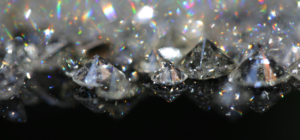 Much of a gemstone’s perceived beauty lies in the performance of how light reflects and refracts throughout the stone. Reflection is the amount of light that bounces off the surface of a gemstone and is returned to the eye. This is the “sparkle” of a gemstone. Refraction is how the gemstone bends the light in different directions, separating white light into its spectral colors. This is called dispersion, and is the “fire” of the gemstone. Transparent and translucent gemstones each have their own refractive index, which is a numerical indication of their dispersion. The higher the R.I. of a gemstone, the more dramatic is the dispersion. In addition to reflection and refraction, many gemstones have unique properties that allow them to display amazing special effects with light, adding greatly to their appeal. Nearly all optical phenomena are totally dependent on how the gemstone is cut. Here you will learn about the spectacular special effects that some gemstones are capable of displaying.
Much of a gemstone’s perceived beauty lies in the performance of how light reflects and refracts throughout the stone. Reflection is the amount of light that bounces off the surface of a gemstone and is returned to the eye. This is the “sparkle” of a gemstone. Refraction is how the gemstone bends the light in different directions, separating white light into its spectral colors. This is called dispersion, and is the “fire” of the gemstone. Transparent and translucent gemstones each have their own refractive index, which is a numerical indication of their dispersion. The higher the R.I. of a gemstone, the more dramatic is the dispersion. In addition to reflection and refraction, many gemstones have unique properties that allow them to display amazing special effects with light, adding greatly to their appeal. Nearly all optical phenomena are totally dependent on how the gemstone is cut. Here you will learn about the spectacular special effects that some gemstones are capable of displaying.
What is Chatoyancy?
- Chatoyancy: Certain gemstones when cut in a cabochon will exhibit chayotance; a brightly reflected single line that moves across the surface of the gemstone when the stone is rotated. Tiger’s eye is one of the best known examples of a gem that exhibits chayotance. The word is derived from the French chatoyer, meaning “to gleam like a cat’s eye.”
What are Asterisms?
- Asterisms: In gemstones with rutile inclusions, light traveling perpendicular to the three crystal faces will produce a star effect on the top of the cabochon. Star sapphires and star rubies provide the best examples of asterism. The Star of India is a 563 carat star sapphire and is housed at the American Museum of Natural History. It is the best known and largest star sapphire in the world.
What is Adularescence?
- Adularescence: The “inner glow” of a cabochon gemstone. When light seems to emanate from within the gemstone, this phenomenon is called adularescence. Moonstone is a prime example of a gem exhibiting adularescence. The most desirable effect displays when the moonstone is very clear and the adularescence is blue. The sheen will travel across the surface of the crystal when the stone is turned. Some quartz may also show adularescence, but moonstone, or adularia as it is also known, presents it best.
What is Iridescence?
- Iridescence: The phenomenon where a gemstone will display different colors depending on the viewing angle. Good examples of iridescent gemstones are opal, labradorite, and ammolite. Opals are formed by the action of warm water on volcanic glass. Water particles become trapped during the cooling process. The iridescence you see is actually liquid inclusions. Labradorite has an almost metallic sheen due to variations in its mineral composition. Another descriptive term for iridescence is schiller.
What is Color change in gemstones?
- Some gemstones will display dramatic changes in color when viewed in daylight or incandescent light. Alexandrite is the best known example of a color change gem. In incandescent light, alexandrite will absorb all the spectral colors except for red, which is then reflected back to the eye. Step outside into natural daylight, and alexandrite will absorb the red, reflecting blue. While very rare, some sapphires are capable of color change as well, and can shift from pink to green or from blue to purplish blue depending on the type of light under which they are viewed.
It’s easy to understand how gemstones captivate the eye and capture the imagination. Now that you have a greater understanding about the optical properties of gemstones, has your preference changed? Would you seek out a color change sapphire over a single color sapphire? Semi-precious gems display an exciting range of special effects. Which one is your favorite? Tell us about any special effect gems you may already own.
Read other posts from the Introduction to Gemstones series.
